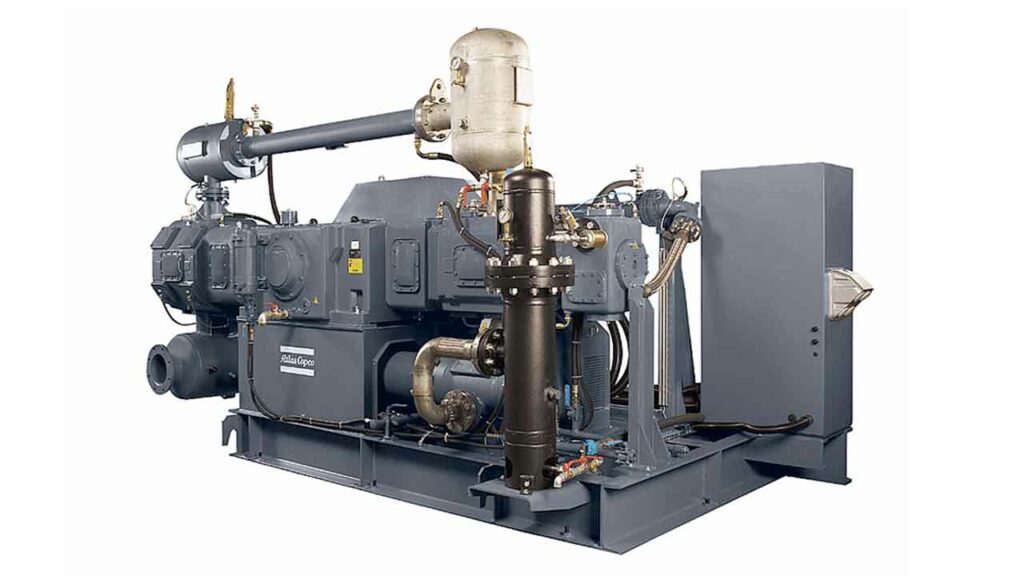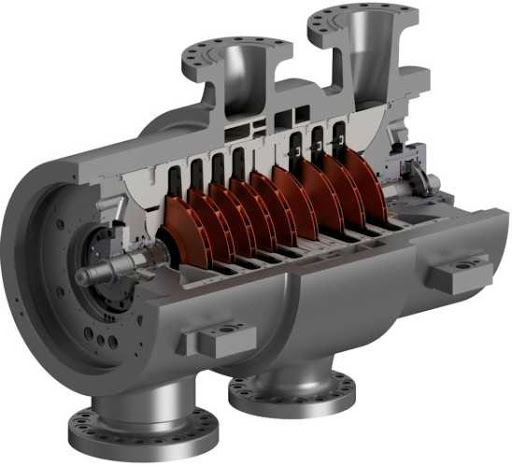Knowing “how does a centrifugal compressor work” depends on multiple factors including knowing its components and its working principles. In this article from Linquip, we want to share the working principles of a simple centrifugal compressor to enable you to understand how they work. So, let’s get started.
How does a centrifugal compressor work?
Centrifugal compressors are considered as a dynamic compressor type that has a radial design. These compressors work with a constant pressure unlike the ones working at a constant flow. Plus, any changes in the external conditions affect the performance. Centrifugal compressors have been designed to use different stages for compressing and cooling the air by converting energy while the air flows throughout the unit. These machines compress a particular vapor or gas by using a radial acceleration with the help of an impeller and a surrounding case.
Getting to know how a centrifugal compressor works
The simple explanation regarding “how does a centrifugal compressor work?” would be that they transform the velocity and the kinetic energy in the diffuser into the pressure energy.
There is a rotating impeller inside centrifugal compressors that has radial blades and the center of this impeller receives the air that is pushed by centrifugal force toward the center. The movement will increase the pressure and generate kinetic energy. When this energy passes through a volute and a diffuser, it will be converted into pressure.
The centrifugal compressor actually increases the air’s velocity and the rotation of the impeller will convert the kinetic energy to the desired form of pressure. The velocity will be decreased in the air flow after the air enters the diffuser section. This component (the diffuser) is static or fixed which helps the air flow to leave the impeller. That is this decrease in velocity which increases the pressure.
The excess moisture will be removed between each compression stage and the air is also cooled during these stages which increases the air quality and its efficiency. Different stages cause pressure to increase to the desired level and as a result, they can serve different industrial plants for their specific requirements. The designers can arrange a different number of stages in order to achieve a higher pressure. Centrifugal compressor working principle is as easy as this.
Popular centrifugal compressors contain 2 to 4 stages to generate pressures up to 150 PSIG. Between each stage, the air will be cooled down for the next stage via an inter-cooler.
Different parts of centrifugal compressors enabling the overall process
Centrifugal compressors usually contain these four main parts: impeller, collector, inlet, diffusor.
The casing and inlet are used to protect the components inside. This case is usually made of cast iron or steel and has two types: horizontally split and vertically split. The bearings in the case provide axial and radial support of the rotor. Other units that the case contain are nozzles. These nozzles with inlets and discharge flow connections are used for directing the flow in or out from the compressor.
Impellers that are mounted on a shaft are considered as the compressor rotor. This unit has been designed to provide the velocity. The blades that are attached to its rotating disc are positioned based on the desired output.
The other part is the diffuser. The diffuser passage (the tiny space between adjacent diaphragms) receives the gas that has been extracted by the impeller. There the gas flow turns 180° and will be directed to the next impeller. The two walls of the diffuser are used to form a radial channel enabling the decrease in the gas’ velocity and also helps to convert the dynamic pressure into static pressure.
The collector (also known as the scroll or the volute) is the last item in the most important parts that enables you to understand the answer to “how does a centrifugal compressor work”. The collector sometimes contains valves for controlling the compressor. But their main job is to collect the gas at the last process. The collector then delivers the collected item to the discharge flange.
Watch Video about How Does a Centrifugal Compressor Work
Centrifugal compressor advantages
Knowing “how does a centrifugal compressor work” has also another side. Knowing the construction and working of centrifugal compressor can help you learn more about these compressors’ advantages.
It’s interesting to know that one of the centrifugal compressor advantages is that its design enables a large quantity of air to be produced in a small package. They are suitable for the states with higher than 200 total horsepower applications and are suitable to work in higher capacities. That’s because of their continuous flow through different stages.
Another advantage of these compressors is that with the increase of the system size, the price per HP decreases.
Centrifugal compressor application
Now that you know the answer to how a centrifugal compressor works, you may be interested to briefly learn about its applications. These machines are used for diverse purposes such as producing or obtaining compressed air.
Another use for centrifugal compressors is in gas turbines to provide the desired compression.
Centrifugal compressors are also used in the food industry. They are used for creating compressed air that is oil-free to be used in the food processing industry.
“How does a centrifugal compressor work” is now a question you know the answer to. What do you think about these dynamic centrifugal compressors? Comment below and let us know your opinion. You can also signup on Linquip and talk to our experts to get the answer to all your questions.
Read More on Linquip
- The Differences Between Axial Compressor & Centrifugal Compressor
- Types of Centrifugal Compressor: An Ultimate Guide
- Types of Centrifugal Compressor: An Ultimate Guide
- 3 phase air compressor: what is it and how to wire it
- How an Air Conditioners Compressor Work?
- Types of Centrifugal Compressor: An Ultimate Guide




